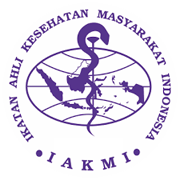HUBUNGAN ASUPAN ZAT GIZI, INDEKS MASSA TUBUH, DAN AKTIVITAS FISIK TERHADAP KADAR KOLESTEROL DARAH TOTAL PADA PASIEN PENYAKIT JANTUNG KORONER DI RSUD KOTA PRABUMULIH
Abstract
Coronary heart disease is heart disease caused by narrowing of the coronary arteries so that an interruption in blood flow to the heart muscle. The main risk factor is a risk factor total cholesterol abnormalities. There are several factors that can affect cholesterol levels, ie intake, body mass index, and physical activity. This study is to assess the relationship between intake of saturated fatty acids, PUFA, MUFA, fiber, niacin, vitamin C, magnesium, lycopene, physical activity and total blood cholesterol levels of patients with coronary heart disease in hospitals Prabumulih. This type of quantitative research with cross sectional study design with 40 respondents. Data taken in this study of the intake of saturated fatty acids, PUFA, MUFA, fiber, magnesium, lycopene, niacin, vitamin C, physical activity and total blood cholesterol levels by researchers. This study data analysis using correlation Pearson Product Moment Correlation. The result showed There is a relationship between the intake of saturated fatty acids (p = 0.02), MUFA (p = 0.000), fiber (p = 0.016), physical activity (p = 0.000), BMI (p = 0.001) and total blood cholesterol levels. There was no relationship PUFA intake, magnesium, lycopene, niacin, and vitamin C with total blood cholesterol levels (p = 0.682; p = 0.568, p = 0.112, p = 0.062; p = 0.181).
The intake of saturated fatty acids, MUFA, fiber, physical activity, BMI is a factor that affects the total blood cholesterol levels.
 Keywords: saturated fatty acids, fiber, magnesium, lycopene, vitaminÂKeywords
Full Text:
PDF (Bahasa Indonesia)References
Almatsier, Sunita. (2010). Prinsip Dasar Ilmu Gizi. Jakarta : PT Gramedia Pustaka Utama.
Bender A David. (2012). Biokimia Harper. Mikronutrien : Vitamin dan Mineral. Jakarta: EGC.
Darawati,Made. (2016). Ilmu Gizi: Teori dan Terapan. Mineral. Jakarta : EGC.
Deeg, M. (2006). Variations in Lipid Values. TB003. 2006; 1(3).
Depkes. (2017). Penyakit Jantung Penyebab Kematian Tertinggi, Kemenkes Ingatkan CERDIK. Depkes RI.
Doloksoribu, B. (2017). Ilmu Gizi Teori dan Aplikasi :Lemak. Jakarta: EGC.
Rustan, A.C dan Christian, A.D. (2005). Fatty Acids L Structures and Properties. Norwegia : Universitas Oslo.
Mackay Judith, dan Mensah George A, (2004). The Atlas of Heart Disease and Stroke. Geneva WHO, 30-49.
Naland, Henry. (2003). Kombucha The Ajaib Pencegah an Penyembuh Aneka Penyakit. Jakarta : Agromedia Pustaka.
Perreta. (2010). Makanan Untuk Otak. Jakarta : Penebar Swadaya.
Rao, A. V. dan L. G. Rao. (2003). Lycopene and Human Health. Nutritional Genomics and Functional Foods. 1 : 35-44.
Riset Kesehatan Dasar. (2007). Jakarta: Badan Penelitian dan PengembanganKesehatan, Departemen Kesehatan, Republik Indonesia.
Riset Kesehatan Dasar. (2013). Jakarta: Badan Penelitian dan PengembanganKesehatan, Departemen Kesehatan, Republik Indonesia.
Ristić-Medić, Danijela., et al. (2013). Polyunsaturated Fatty Acid in Health and Desease. Journal of the Serbian Chemical Society 78 (9) 1269-1289.
Schwingshackl, Lukas dan Georg Hoffman. (2012). Monounsaturated Fatty Acids and Risk of Cardiovascular Disease: Synopsis of the Evidence Available from Systematic Reviews and Meta- Analyses. Jurnal Nutrients ISSN 2072-6643.
Sitepu, Indah Whidysenandri. (2014). Hubungan Antara IMT dengan Kadar Profil Lipid Darah pada Pasien Dewasa di Bagian Penyakit dalam Rumah Sakit PHC Surabaya. Universitas katolik Widya Mandala Surabaya.
Sulastri D, et al. (2003). Pola Asupan Lemak, Serat, dan Antioksidan, serta Hubungannya dengan Profil Lipid pada Etnik Minangkabau. Maj Kedokt Indonesia. 2003 Feb; 55 (2):1-6.
Sutrisno, Desire,.et al. (2015). Gambaran Profil Lipid pada Pasien Penyakit Jantung Koroner. Jurnal e-Clinic (eCl), Volume 3, Nomor 1, Januari-April 2015.
Sugiani, PPS.,et al. (2004). Asupan Gizi sebagai Faktor Risiko Penyakit Infark Miokard Akut di RS Sanglah Denpasar. Jurnal Gizi Klinik Indonesia 2004; 1(2): 67-65.
Thompson P.D., Rader D.J. (2001). Does Exercise Increase HDL Cholesterol in Those Who Need It the Most. Arteriosclerosis, Thrombosis, and Vascular Biology. American Heart Association, 21:1097-1098.
Tuminah, S. (2009). Efek Asam Lemak Jenuh dan Asam Lemak Tak Jenuh “Trans†terhadap Kesehatan. Media Penelitian dan Pengembangan Kesehatan volume XIX tahun 2009, suplemen II.
Yusuf, F., Sirajuddin, S., Najamuddin, U. (2013). Analisis Kadar Asam Lemak Jenuh dalam Gorengan dan Minyak Bekas Hasil Penggorengan Makanan Jajanan di Lingkungan Workshop Universitas Hasanudin. Program Studi Ilmu Gizi Fakultas Kesehatan Masyarakat Universitas Hasanudin.
Zuhroiyyah SF, dkk. (2017). Hubungan Aktivitas Fisik dengan Kadar Kolesterol Total, Kolesterol, LDL, dan Kolesterol HDL pada Masyarakat Jatinangor. JSK, Vol.2 No. 3 Maret 2017. FK Universitas Padjajaran.
DOI: https://doi.org/10.47007/hp.v1i01.3268
Refbacks
- There are currently no refbacks.
Copyright (c) 2020 Health Publica
Lembaga Penerbitan Universitas Esa Unggul
Jalan Arjuna Utara No 9 Kebon Jeruk Jakarta 11510
Telp : 021 5674223 ext 266
View My Stats


2.png)






